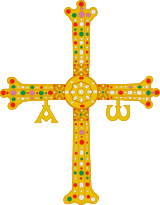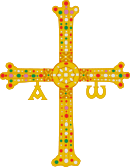- Cathedral of San Salvador, Oviedo
-
Cathedral of the Holy Saviour
Catedral de San Salvador (Spanish)Façade of the cathedral.
Basic information Location  Oviedo, Spain
Oviedo, SpainGeographic coordinates 43°21′45.30″N 5°50′35.09″W / 43.362583°N 5.8430806°WCoordinates: 43°21′45.30″N 5°50′35.09″W / 43.362583°N 5.8430806°W Affiliation Roman Catholic Ecclesiastical or organizational status Cathedral, Minor basilica Heritage designation World Heritage Site Leadership vacant Website Official Website Architectural description Architect(s) Rodrigo Gil de Hontañón Architectural type Church Architectural style Gothic Direction of façade O Groundbreaking 9th century Monuments of Oviedo and the Kingdom of the Asturias * UNESCO World Heritage Site
Country Spain Type Cultural Criteria ii, iv, vi Reference 312 Region ** Europe and North America Inscription history Inscription 1985 (9th Session) Extensions 1998 * Name as inscribed on World Heritage List
** Region as classified by UNESCOThe Metropolitan Cathedral Basilica of the Holy Saviour (Spanish: Catedral Metropolitana Basílica de San Salvador, Latin: Sancta Ovetensis) is a Roman Catholic cathedral and minor basilica in the centre of Oviedo, in the Asturias region of northern Spain.
The cathedral of San Salvador of Oviedo remains today as a unique example of different architectural styles, from Pre-Romanesque to Baroque, including Romanesque, Gothic and Renaissance parts. Originally, there was a big Pre-Romanesque basilica in the present location of the Sothic cathedral, but nothing is known about that first building (which was built by order of King Alfonso II of Asturias The Chaste).
Contents
History
The Cathedral was founded by King Fruela I of Asturias in 781, and enlarged in 802 by Alfonso II of Asturias, who made Oviedo the capital of Kingdom of Asturias, and with his Court resided here. He created the See of Oviedo in 810. The present edifice was begun by Bishop Gutierre of Toledo in 1388, and the tower added by Cardinal Francisco Mendoza de Bobadilla in 1528.
The Cathedral was restored in the 12th century by Archbishop Pelayo, the chronicler. Bishop Fernando Alfonso (1296–1301) undertook another restoration of the chapter-house, and his successor, Fernando Alvarez (1302–1321), began the cloister. At the end of the 13th century Gutierre de Toledo began the new Gothic basilica, the principal chapel bearing his arms, though it was completed by his successor Guillén. Diego Ramirez de Guzmán (1421–41) built the two chapels of the south transept (now replaced by the sacristy), the old entrance to the church, and the gallery of the cloister adjoining the chapter-house. Alonzo de Palenzuela (1470–85) completed the other part of the transept. Juan Arias (1487–97) left his cognizance, the fleur-de-lys and four scallops, on the nave. Juan Daza (1497–1503) erected the grille of the choir; Valerano (1508–12) added the stained-glass windows. Diego de Muros, founder of the great college at Salamanca known as the Oviedo, had the crestings of the porch wrought by Pedro de Bunyeres and Juan de Cerecedo, while Giralte de Bruselas and Juan de Balmaseda completed in the years 1512 to 1517 the carving of the precious altarpiece ordered by Valeriano Órdoñez de Villaquirán. Cristóbal de Rojas (1546–56) affixed his coat-of-arms to the completed tower, with its octagonal pyramid, one of the marvels of Gothic architecture.
Building
There are some Romanesque remains, as the Southern Tower, or the upper part of the Holy Chamber, which includes a fantastic collection of Romanesque column-statues. The cathedral of San Salvador is mainly a fine gothic building, which was built between 14th and 16th centuries in a Classic and Flamboyant Style. The Chapter Room, whose construction was started in 1388,was the first part of the new gothic cathedral to be finished: built in a classic gothic fashion (including a great eight-sided dome), it was followed by the cloister and the choir (ca.1400). The naves were built once the choir was finished,all through the 15th century. We can admire the progression of the constructive stages, taking as an example the tracery of windows and tryphorium. The sanctuary is still a classical-gothic work, whereas the naves present typical flame-like elements typical of a late-gothic style.
The latest medieval part, the narthex, was designed by Juan de Badajoz, whose original project included a double-towered facade (though due to financial issues, only a tower was built). This western tower, one of the best examples of Flamboyant Gothic in Spain, was finished by architect Gil de Hontañón, who added to the structure an openwork chapitel in a modern Renaissance style. Renaissance is also represented by the unique altarpiece placed at the end of the choir, a great piece of sculpture and painting, maybe one of the best of Spain in its kind.
Baroque elements include some lateral private chapels (Capilla de los Vigiles), the Pantheon of Asturian Kings and the ambulatory (recently restored). There are some relevant altarpieces in a profuse baroque fashion too.
Cámara Santa
Main article: Cámara Santa, OviedoThe cathedral was also called Sancta Ovetensis[1]; owing to quantity and quality of relics contained in the Cámara Santa (English: Holy Chamber). The Holy Chamber remains as the only sample of the ancient high-medieval complex. It was built as a relics' room to keep the different treasures associated to the Asturian Monarchy (Cross of Angels, Cross of Victory, Agatha Box).
The chief feature of the cathedral is the "Camara Santa", with its venerable relics. Bishop Pelayo relates that the Agatha Box, a coffer made by the disciples of the Apostles, and containing the most precious relics of the Holy City, was taken from Jerusalem to Africa, and after several translations was finally deposited at Oviedo by Alfonso II. In the 16th century, Bishop Cristóbal de Sandoval y Rojas wished to open it, but could not, being overcome with religious fear. Many other relics are to be seen.
Burials
- Saint Eulogius of Córdoba
- Fruela I of Asturias
- Munia Lopez de Gascogne, wife of Fruela I
- Teresa de Leon, wife of Sancho I of León
- Jimena De Pamplona, wife of Alfonso III of León
- Saint Leocadia, relics later moved from Oviedo
- Saint Pelayo (912-925)
Notes
- ^ Ford, Richard (1855). "The Asturias". A handbook for travellers in Spain. II. John Murray. pp. 635–651. http://books.google.be/books?id=_xQJAAAAQAAJ&printsec=titlepage#PPA63.
See also
References
- Collins, W. W. (1909). "Oviedo". In Dodd, Mead and company. Cathedral cities of Spain. New York. http://www.archive.org/stream/citieso00collcathedralrich.
External links
 This article incorporates text from a publication now in the public domain: Herbermann, Charles, ed (1913). "Diocese of Oviedo". Catholic Encyclopedia. Robert Appleton Company.
This article incorporates text from a publication now in the public domain: Herbermann, Charles, ed (1913). "Diocese of Oviedo". Catholic Encyclopedia. Robert Appleton Company.Pre-romanesque art in the Kingdom of Asturias Pre-Romanesque art in Asturias is framed between the years 711 and 925, the period of the rise and extension of the Kingdom of Asturias.Architecture 1st Period (737 to 791)Santa Cruz de Cangas de Onís • Church of San Juan Apóstol y Evangelista2nd Period (791 to 842)Cathedral Basilica of San Salvador • Pilgrimage church of Santiago de Compostela • Church of San Tirso • Church of San Julián de los Prados • Church of Santa María de Bendones • Church of San Pedro de Nora • Church of Santiago de Gobiendes • Cámara Santa of Oviedo3rd period (842 to 866)Church of Santa María del Naranco • Church of San Miguel de Lillo • Church of Santa Cristina de Lena4th period (866 to 910)5th period (910 to 925)
Infrastructure La FoncaladaMajor figures Minor arts Spiritual legacy World Heritage Sites in Spain For official site names, see each article or the List of World Heritage Sites in Spain.North West Caves of Altamira and Paleolithic Cave Art of Northern Spain1 · Monuments of Oviedo and the Kingdom of the Asturias · Roman Walls of Lugo · Route of Santiago de Compostela1 · Santiago de Compostela · Tower of Hercules
North East Caves of Altamira and Paleolithic Cave Art of Northern Spain1 · Mudéjar Architecture of Aragon · Pyrénées - Mont Perdu2 · Rock-Art of the Mediterranean Basin on the Iberian Peninsula1 · Route of Santiago de Compostela1 · San Millán Yuso and Suso Monasteries · Vizcaya Bridge
Community of Madrid Aranjuez Cultural Landscape · El Escorial · University and Historic Precinct of Alcalá de Henares
Centre Archaeological Ensemble of Mérida · Archaeological Site of Atapuerca · Ávila with its Extra-mural Churches · Burgos Cathedral · Cáceres · Cuenca · Las Médulas · Rock-Art of the Mediterranean Basin on the Iberian Peninsula1 · Route of Santiago de Compostela1 · Salamanca · Santa María de Guadalupe · Segovia and its Aqueduct · Toledo · Prehistoric Rock-Art Sites in the Côa Valley and Siega Verde
East Archaeological Ensemble of Tarraco, Tarragona · Catalan Romanesque Churches of the Vall de Boí · Ibiza (Biodiversity and Culture) · Palau de la Música Catalana and Hospital de Sant Pau, Barcelona · Palmeral of Elche · Poblet Monastery · Rock-Art of the Mediterranean Basin on the Iberian Peninsula1 · Silk Exchange in Valencia · Works of Antoni Gaudí
South Alhambra, Generalife and Albayzín, Granada · Cathedral, Alcázar and Archivo de Indias, Seville · Córdoba · Doñana · Renaissance Monuments of Úbeda and Baeza · Rock-Art of the Mediterranean Basin on the Iberian Peninsula1
Canary Islands 1 Shared with other region/s · 2 Shared with FranceCategories:- Cathedrals in Spain
- Basilica churches in Spain
- 8th-century church buildings
- Churches in Asturias
- Buildings and structures in Oviedo
- Gothic architecture in Spain
Wikimedia Foundation. 2010.


